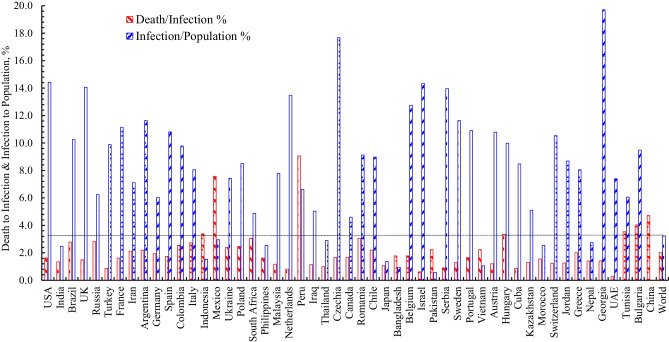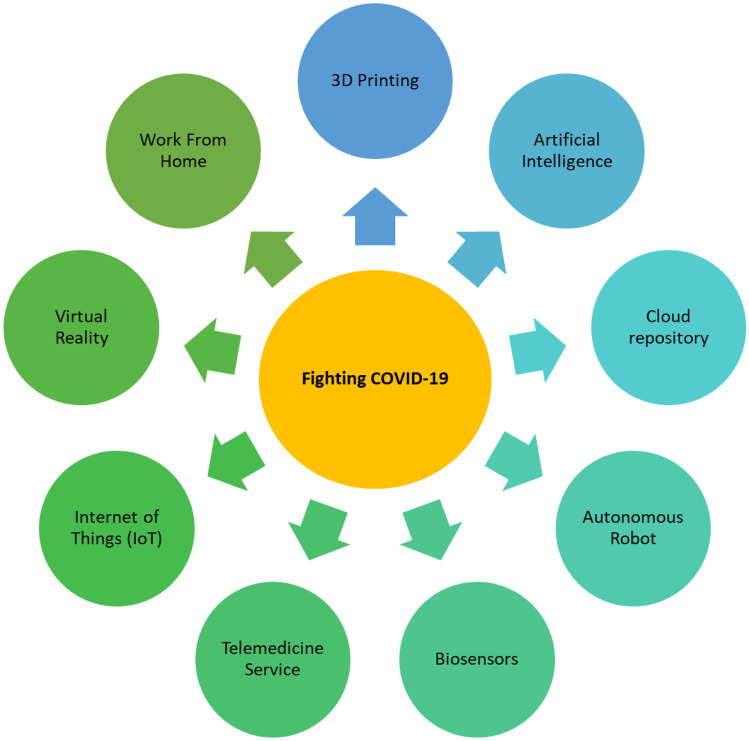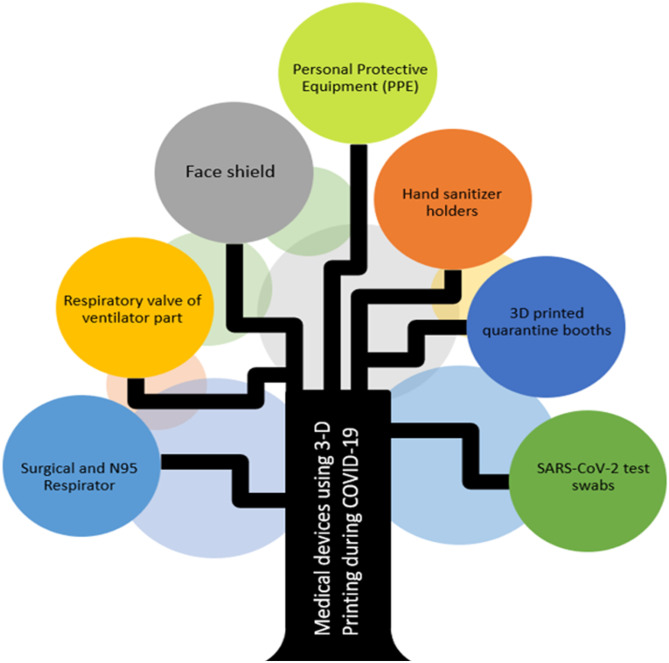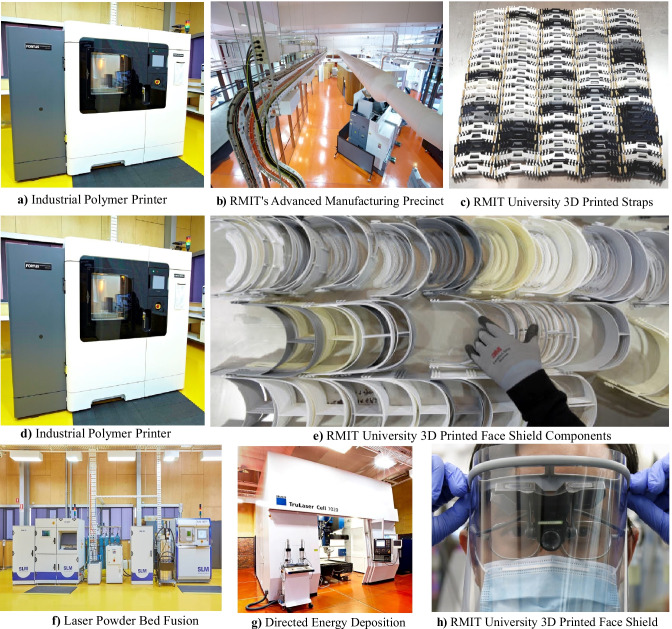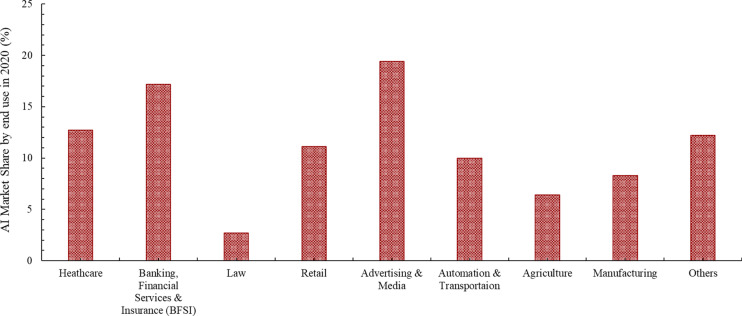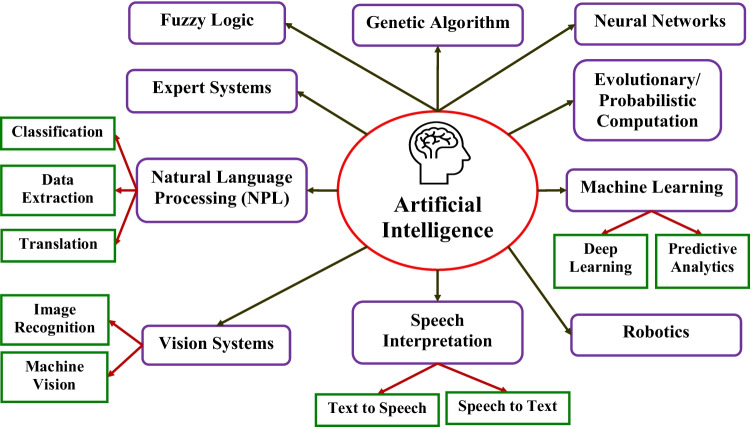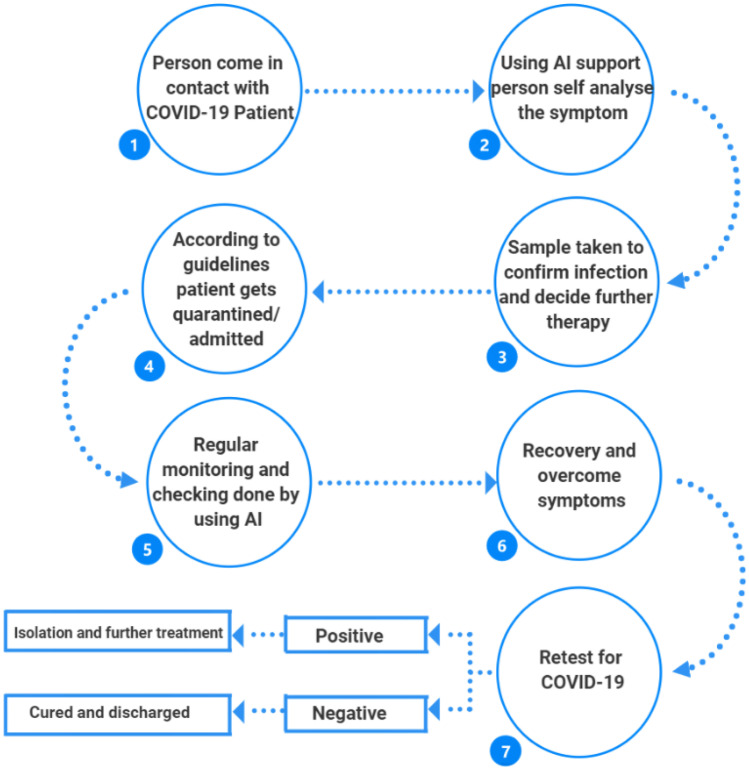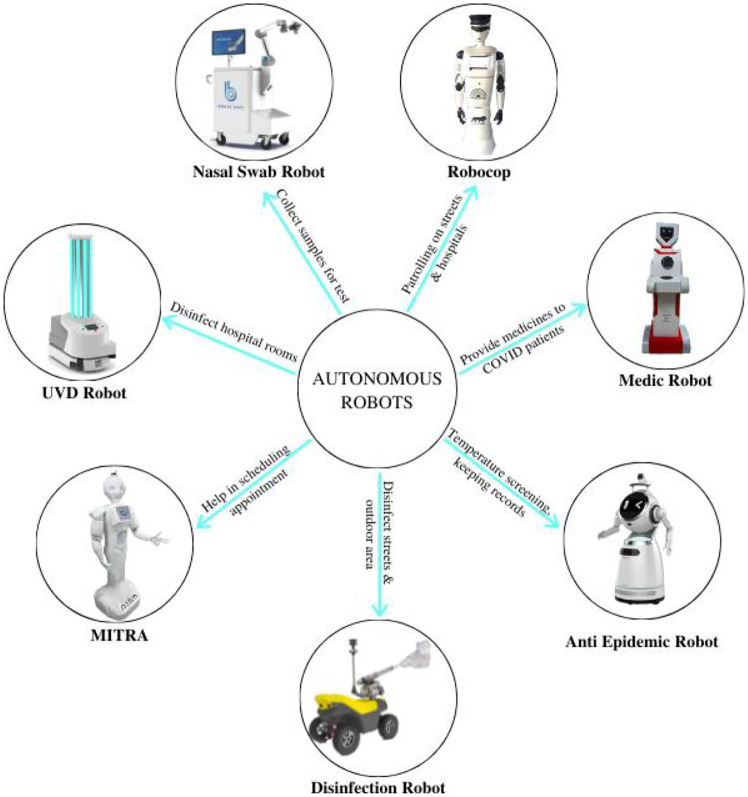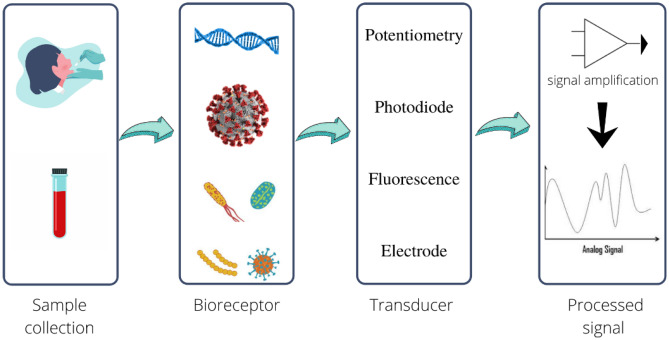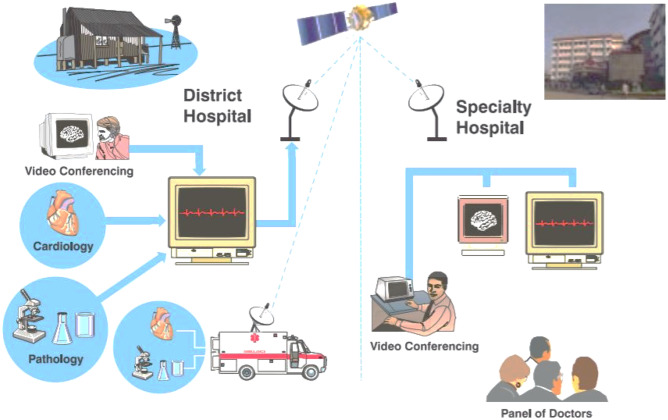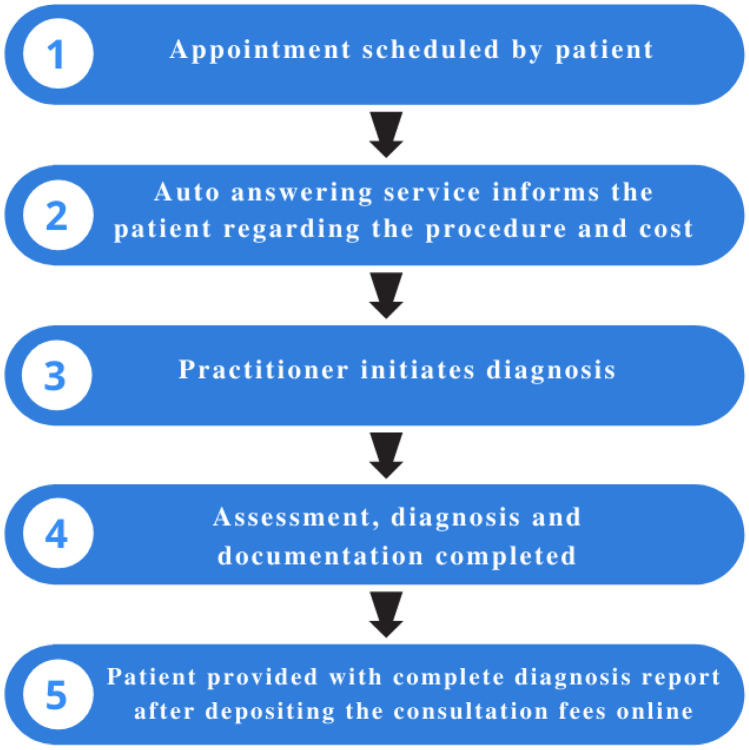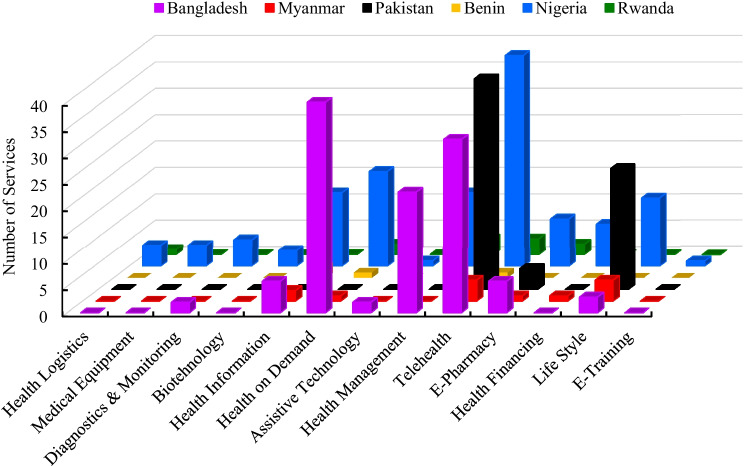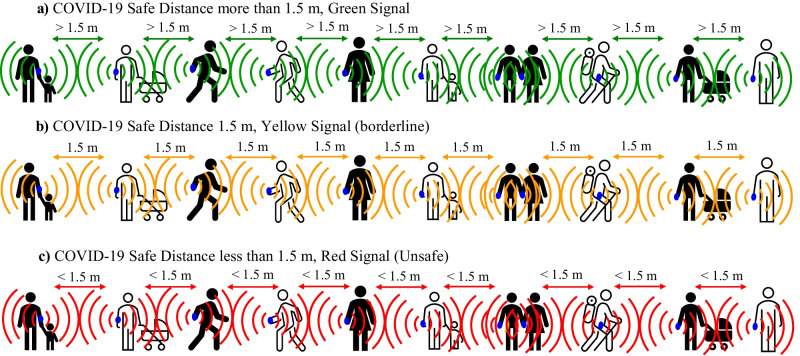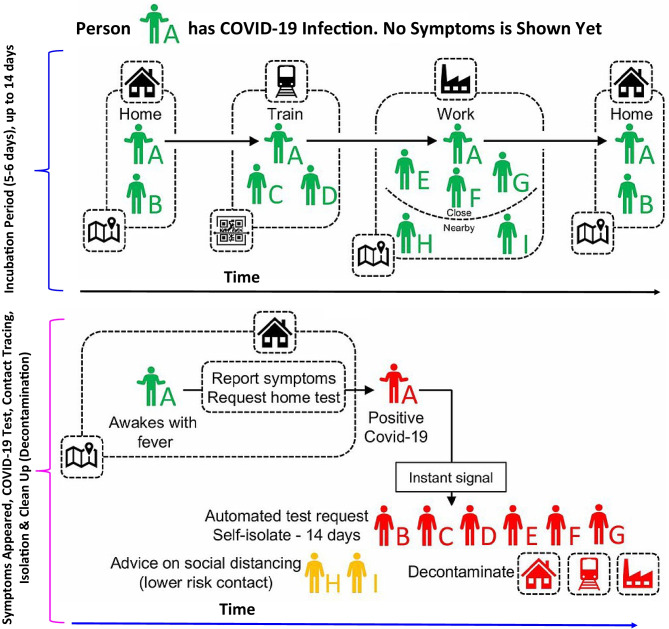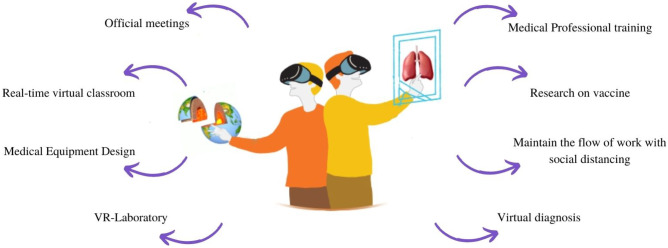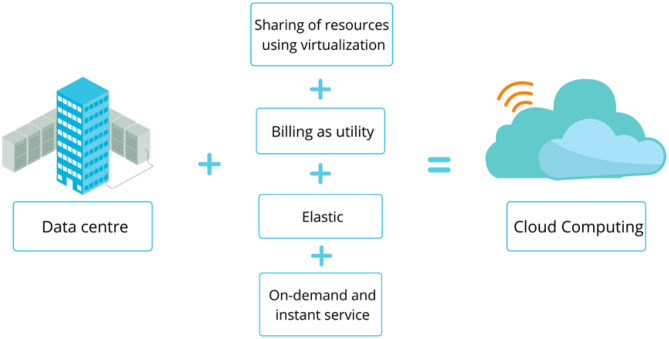Abstract
COVID-19 pandemic created a global health crisis affecting every nation. The essential smart medical devices/accessories, quarantine facilities, surveillance systems, and related digital technologies are in huge demand. Healthcare, manufacturing industries, and educational institutions need technologies that allow working from a safe location. Digital technologies and Industry 4.0 tools have the potential to fulfil these customized requirements during and post COVID-19 crisis. The purpose of this research is to provide understanding to healthcare professionals, government policymakers, researchers, industry professionals, academics, and students/learners of the paradigm of different Digital technologies, Industry 4.0 tools, and their applications during the COVID-19 pandemic. Digital technologies, Industry 4.0 tools and their current and potential applications have been reviewed. The use of different Digital technologies and Industry 4.0 tools is identified. Digital technologies and Industry 4.0 tools (3D Printing, Artificial Intelligence, Cloud Computing, Autonomous Robot, Biosensor, Telemedicine service, Internet of Things (IoT), Virtual reality, and holography) offer opportunities for effective delivery of healthcare service(s), online education, and Work from Home (WFH) environment. The article emphasises the usefulness, most recent development, and implementation of Digital technologies, Industry 4.0 techniques, and tools in fighting the COVID-19 pandemic worldwide.
Keywords: COVID-19, Industry 4.0, Digital technologies, Healthcare, Telemedicine
Introduction
The Corona Virus Disease 2019 (COVID-19) named by World Health Organisation (WHO) emerged in Asia late 2019. As of 16 November 2021, 255 million people were infected and over five million people died globally [1]. The virus spread to 220 countries in Asia, Europe, North and South America, Africa, Australia, and Oceania. The ratios of infection to population and death to the population for the top 50 affected countries and a low affected country (China) are shown in Fig. 1. No countries rich or poor could escape the mayhem of COVID-19. The top 8 countries’ ratio of infected people to the total population (of a country) are 20% in Georgia, 17.7% in Czechia, 14.4% in the USA, 14.3% in Israel, 14.1% in the UK, 14% in Serbia, 13.5% in the Netherlands, and 12.8% in Belgium. Among countries with population over 100 million, China reported the lowest infection to population (0.007%) followed by Pakistan (0.6%), Bangladesh (0.9%), Japan (1.4%), Indonesia (1.5%), and India (2.5%). The highest death to infection percentage was reported in Peru (9.1%), followed by Mexico (7.6%) and China (4.7%). The world average infection to population and death to infection were 3.2% and 2.0%, respectively (Fig. 1). WHO declared COVID-19 a global pandemic as it created an unprecedented crisis in health, economy, education, global mobility, culture, sports, etc. that our human civilisation never saw from time immemorial [1]. The International Committee on Taxonomy of Viruses (ICTV) called it a severe acute respiratory syndrome coronavirus 2 (SARS-CoV-2) on 11 February 2020. To stop the spread, nationwide shutdowns were imposed in all continents disrupting nearly all physical communications and forcing them to undertake activities remotely from homes or safe places. The demand for digital access, technologies, equipment, life protecting/ saving devices, and tools was increased at an unprecedented level. Access difficulties to medical facilities and healthcare services due to COVID-19 emergencies are creating a significant impact on both healthcare service receivers/ users and service providers/ suppliers. Furthermore, digital divides among developed and developing nations, urban and rural populations, economic and cultural disparity make healthcare services more challenging and inaccessible. Available information and data on the COVID-19 pandemic affecting healthcare systems in emerging and developing countries allow evaluating digital technologies and Industry 4.0 tools that are progressively being used and can have a notable impact on healthcare delivery during the COVID-19 pandemic. Therefore, this study aims to provide understanding to healthcare professionals, government policymakers, researchers, industry professionals, academics, and students/learners of the paradigm of different Digital Technologies, Industry 4.0 tools and their applications during the COVID-19 pandemic. The study is based on data and information collected from open and subscribed literature/ databases, individual/ personal contacts, government sources, press reports, news, media portal, and case studies.
Fig. 1.
Worldwide ratios of Infection to Population and Death to Infection, adapted from [1]
Major indexing and search engine tools such as Google Scholar, Scopus, IEEE Xplore, Research Gate, PubMed, Academic Info, Microsoft Academic Search, JournalSeek, MEDLINE, Science Direct, Web of Science, SpringerLink, Wiley Online Library, Emerald, LinkedIn Learning (formerly Lynda.com), Factiva, ProQuest Central, IBISWorld, and data published by governments were used to get relevant information for this study. The study includes information on all advanced digital technology inventions/ innovations, development, and uses of Industry 4.0 in healthcare service delivery during the COVID-19 pandemic. Findings are expected to help healthcare professionals, academics, researchers, policymakers, industry professionals, students, and community members to understand the paradigm of Industry 4.0 and their implementation approaches during the pandemic. Advances in digital technologies in such a short interval of time can be a paradigm shift for different industries in the future. The technologies that emerged during the COVID-19 pandemic will get applications in many other areas.
Digital technologies and industry 4.0
Industry 4.0 or the fourth industrial revolution is the interconnection of digital technologies with modified advanced manufacturing and production systems often called “Smart Manufacturing or Smart Factory”. The Smart Manufacturing technology of Industry 4.0 has abundant potential for demand-driven supply chain services during the COVID-19 crisis [2]. Figure 2 shows four main phases of the industrial revolution.
Fig. 2.
Major phases of Industrial Revolution, adapted from [3]
Digital technologies including artificial intelligence, cloud computing, big-data analytics, Internet of Things (IoT), deep learning and blockchain technology can solve the major medical and clinical problems [4, 5]. Consequently, the Industry 4.0 generation can interlink the industrial revolution and medical field to fight against coronavirus by using its advanced information technology applications and modified advanced manufacturing. The demand for essential medical accessories can be mitigated using 3D printing devices and using various digital technologies. Javaid et al. [6] provided a brief overview of Industry 4.0 technologies and their applications in fighting COVID-19. Shashank et al. [7] highlighted the operational aspects of Industry 4.0 during the COVID-19 pandemic. Khan et al. [8] reviewed various smart technologies including the application of drones, robots, artificial intelligence, and sensor technology that helped in mitigating the spread of COVID-19 pandemic.
Technological innovations between the real and virtual worlds and sustainable supply chain performance during COVID-19 were studied [9]. Reviews of Digital Technologies in various domains that emerged during the COVID-19 pandemic were carried out by several researchers [10–12]. Healthcare services, educational institutions and industries have been affected the most during lockdown since March 2020. For example, apart from COVID patients, non-COVID vulnerable populations are deprived of primary healthcare services as many doctors including General Practitioners (GPs), nurses, clinics, medical centres, and hospitals, are reluctant to provide healthcare services, fearing coronavirus exposure. Healthcare professionals prefer to provide their services remotely where possible. In 2020, 1.5 billion students in 188 countries/economies were locked out of their schools [13]. In South Asia alone, over 400 million school children were locked out of schools for 19 months. Campuses are closed for university students in most countries including Australia, New Zealand, Bangladesh, India, Pakistan since March 2020. With the COVID-19 pandemic still raging, many education systems are struggling, and the situation is constantly evolving from school closures and remote learning. Commercial and industrial sectors have severely been affected by the pandemic. Continuous ‘off and on’ lockdowns and the requirement for social and safe distancing at the workplace and industry are affecting not only productivity but also education and healthcare delivery. The use of digital technologies/Industry 4.0 techniques can significantly minimise the impact of the COVID-19 pandemic [14]. For example, to prevent the spread of COVID-19, people were isolated to work and study from home. IoT solutions/virtual reality such as Microsoft Teams/ Zoom meetings/ Google Meet/ Tencent (VooV), virtual education platforms (Blackboard, Moodle, Canvas, etc.) are increasingly being used to continue commercial services/ operations, industrial activities, healthcare services delivery, and teaching and learning activities. Figure 3 shows some Digital Technologies and tools that have immense potentials and/or are already for use in COVID-19 impact mitigation.
Fig. 3.
Digital technologies and Industry 4.0 techniques to fight COVID-19
A detailed review of applications of feasible Digital Technologies and Industry 4.0 tools/ techniques was undertaken that are being used across the world in fighting the COVID-19 pandemic. Figure 3 outlines vital Digital Technologies, and tools selected for review such as a) 3D Printing of medical devices, b) Artificial Intelligence, c) Cloud Repository for infected patients, d) Autonomous Robot, e) Use of Biosensors, f) Telemedicine Services, g) Internet of Things (IoT), h) Augmented Reality/Virtual Reality and Holography for online education, and i) Creating a Work from Home (WFH) environment using Cloud Computing. Each of these technologies and tools is analysed in the following subsections.
3-D printing technology for medical devices
Three-dimensional (3D) printing is a computer-controlled process that creates three-dimensional objects by depositing materials, usually in layers using computer-aided design. It allows manufacturing complex shapes (e.g., precise geometric shapes), generally harder with the conventional manufacturing process. The technique is commonly known as Additive Manufacturing (AM) and Rapid Prototyping [15]. 3D printing does not require a large and complex industrial setup to manufacture a product and can be operated and controlled remotely using cloud technology requiring a minimal workforce [16]. This computer-aided design (CAD) manufacturing technology is used to manufacture customized medical implants, tools, and devices. During COVID-19, it came as an emerging technology in the medical field for manufacturing medical devices including face masks (e.g., surgical and N95/KN95/P2 Respirator), ventilator respiratory valve, face shield, Personal Protective Equipment (PPE), hand sanitiser holders, door handle attachments, 3D printed quarantine booths, SARS-CoV-2 test swabs, Oxygen valves, etc. [16–18], which are shown in Fig. 4. Additional 3-D printed products developed during this pandemic include 3D printed face shield by Siemens Centre of Excellence of NIT, Tiruchirappalli [20], re-usable face mask by Virtual Frontier Robotics Private Limited, Coimbatore-based start-up in India, helmet systems as PPE [21], KUKA test robot [22], etc.
Fig. 4.
Medical devices being developed using 3-D Printing during COVID-19
In response to the COVID-19 emergency in April 2020, the Advanced Manufacturing Precinct (AMP) of RMIT University, Melbourne, Australia has manufactured over 3,000 face shields using 3D Printing technology and supplied various hospitals and healthcare centres (as shown in Table 1) to enhance frontline healthcare personnel’s protection against airborne droplets that can carry the COVID-19 virus. This effort by RMIT University was timely to overcome the acute shortage of protective gears in the early stage COVID-19 outbreak in 2020. Examples of RMIT University 3D printed face shields, straps and 3D printers are shown in Fig. 5.
Table 1.
RMIT 3D Printed Face Shields donated to Healthcare Services, adapted from [23]
| Healthcare Services | |
|---|---|
|
1) Launceston General Hospital, Tasmania 2) Albury Wodonga Health, New South Wales 3) Box Hill Hospital, Melbourne, Victoria 4) Austin Health, Melbourne, Victoria 5) Royal Melbourne Hospital, Victoria 6) Biofix 3D 7) Northern Anaesthetics 8) Newcastle Private Hospital, New South Wales 9) Alfred Hospital, Melbourne, Victoria 10) Peter McCallum Cancer Centre 11) Eastern Health, Victoria 12) Oral & Maxillofacial Surgeon 13) SVHM Pharmacy |
14) St Vincent's Hospital Public/Private 15) Ear Nose and Throat Victoria 16) Royal Victoria Eye and Ear Hospital 17) Westmead Paediatric ENT 18) Warrnambool ENT's, Victoria 19) Tasmania ENT's 20) Sunshine ENT's 21) Individual ENT's in Victoria 22) Individual ENT's in New South Wales 23) Guy's and St. Morris ENT (London UK) 24) Individual ENT's of Southampton, UK 25) Melton Dentist |
Fig. 5.
Face shield and straps manufactured by 3-D Printing at RMIT University in the beginning of COVID-19 pandemic, adapted from [23]
Artificial intelligence
Humans possess nature gifted intelligence to easily distinguish between objects just by using sensory organs. However, machines work better with numbers and calculation processes. While machines do not tire out and are increasingly more fast, accurate, and precise than humans, they fail to recognize objects. Artificial Intelligence (AI) is the technique/ technology that simulates human-like intelligence in machines. In contrast, a machine without the AI fails to recognise objects due to a lack of technological capability (sensors, imagery, movement, etc.). In short, AI enables a machine to simulate human behaviour while a machine using a subset of AI automatically learn from past data without programming explicitly. The goal of AI is to make a smart computer system like humans to solve complex problems.
The value of the global AI market size in 2020 was US$ 62.4 billion and it is expected to reach US$ 1,033 billion by 2028 [24]. The advancement by research and innovation accelerates the adoption of advanced technologies in healthcare, banking, financial services, and insurance (BFSI), advertising, media, automation, transportation, manufacturing industries, retails, etc. as shown in Fig. 6. Healthcare, advertising, media, Business, Financial Services, and Insurance – BFSI are the leaders in the utilisation of AI. The global AI constitutes by a) Component (hardware, software), b) Technology (machine learning, natural language processing, etc.), c) Application (medical imaging, robotics, smartphones, smart wearables, automobile, security systems, etc.), and d) Vertical (healthcare, advertising and media, business financial services and insurance – BFSI, consumer electronics, information technology & telecommunication, automobile, retail, etc.).
Fig. 6.
Global Artificial Intelligence market share, by end-use in 2020, adapted from [24]
The basic element of AI is shown in Fig. 7. The AI is considered the foundation of the impending digital era. Technology giants such as Amazon, Google, Apple, Facebook; IBM, Microsoft, Intel, Samsung, Huawei, Xilinx, Micron, NVIDIA, Qualcomm, and others are heavily investing to lead the AI sector globally.
Fig. 7.
Major elements of Artificial Intelligence (AI)
The analysis techniques of Big Data with the help of AI can be employed in COVID-19 healthcare data management and tracing the history of COVID-19 infected people [25]. The significant applications of AI in fighting coronavirus disease include detecting infection, monitoring treatment, understanding, and tracking individuals, forecasting cases and mortality rates, developing vaccines and helping in scaling down the workload of healthcare workers [25, 26]. Rajaraman et al. [28] used weekly data of chest X-rays for COVID-19 detection using deep learning at Lister Hill National Center for Biomedical Communications, USA. Yan et al. [29] developed an XGBoost machine learning-based model to predict the mortality rates of COVID-19 patients in advance with 90% accuracy. Cyberbullying materials related to COVID-19 on various social media platforms is detected and removed with the application of AI [30]. Optimization and improvisation against viruses can be undertaken for clinical trials of drugs and vaccines (called drug repurposing) with the use of AI [31]. The AI facilitates reducing steps of the process taken to identify and treat COVID-19 patients. A detailed review of different AI techniques assisting during the COVID-19 pandemic can be found in Alabool et al. [32]. Figure 8 illustrates the potential use of AI in the detection and treatment of COVID-19 patients.
Fig. 8.
Typical flow process of AI-enabled detection and treatment of suspected COVID-19 patient
Cloud repository of infected patients using big data and mask R-CNN
Big Data is an analytic field that extracts desired and detailed information from large and complex data sets [32–34]. Python with its NumPy libraries is one of the prominent computer languages used in the domain of Big Data. Regional Convolutional Neural Networks (R-CNN) has the capability of recognizing objects by marking out rectangular boundaries around them [35]. Mask Regional Convolutional Neural Networks (Mask R-CNN) is a more advanced form of R-CNN which has the capabilities to mark out exact boundaries of recognized objects with almost a single-pixel image precision [36].
A detailed worldwide repository of positive COVID-19 patients with their symptoms, medical history, reports, X-Rays, and CT (Computer Tomography) scans can be made and stored on the cloud so that they can be accessed by registered and authorised medical institutions /practitioners worldwide. This data set can be used to effectively train R-CNN with very high accuracies (above 99%). A trained model can now predict if a patient is suffering from COVID-19 and for how long. This can speed up the testing procedure for COVID-19 where a patient can know whether he/she is COVID-19 positive simply by providing his/her medical history, symptoms, and X-Ray and/or CT scan reports. Ouyang et al. [37] developed a 3D CNN network to assist the diagnosis of COVID-19 patients. Wang et al. [38] used a CNN based Deep Learning (DL) for screening COVID-19 infected patients with an accuracy of 89.5%, a sensitivity of 87%, and specificity of 88% by using their computed tomography (CT) images. A detailed and systematic review of Deep Learning (DL), Deep Transfer Learning (DTL) and Edge Computing (EC) to mitigate COVID-19 was presented by Sufia et al. [39].
Autonomous robot
COVID-19 pandemic has created the need for preventing interhuman contagion and stopping the spread SARS-CoV-2 virus. Using an autonomous robot during the COVID-19 pandemic, it is possible to reduce interhuman contagion, manage, monitor, and control human loitering or purposeless movement during lockdown [39, 40]. A robot can be deployed for disinfection and sanitizing large areas of the containment zone with minimal downtime. It can also help the delivery of food items and medicine to COVID-19 positive patients in hospitals without direct human contact [41–43]. Humanoid robots, autonomous vehicles, quadcopters (commonly known as Drone) and other intelligent robots are excellent examples of Autonomous robots. Examples of some robots used for COVID-19 are shown in Fig. 9.
Fig. 9.
Autonomous robots used for healthcare service delivery including COVID-19 disinfection
Drones played a major role during lockdown for patrolling and analysing containment zones thereby helping the law enforcement and protective agencies. As drones are equipped with advanced cameras, various sensors, and integrated data management systems, they can check an individual’s temperature, heart and breathing rate from a distance and hence, it helped in the rapid testing of COVID-19 cases. Tavakoli et al. [44] examined some other robots including telerobots, collaborative robots, social robots and wearables that can also be used during the COVID-19 situation. Robots along with their applications in fighting the COVID-19 pandemic across the world are given in Table 2.
Table 2.
Robots and their application in fighting COVID-19 pandemic in different nations
| Sl No | Robot | Application | Country |
|---|---|---|---|
| 1 | UVD Robots by Blue Ocean Robotics | Ensure infection-free environments | Denmark |
| 2 | Nasal Swab Robot (NSR) by BNB | COVID-19 Nasal Swab Tests | Taiwan |
| 3 | Zafi Medic robots | Deliver food and medicines to Covid-19 patients under quarantine | India |
| 4 | Autonomous Sanitation Robot by Fab Lab | Uses ultraviolet germicidal irradiation (UVGI) for disinfection | Bahrain |
| 5 | ASTRA-C by Invento Robotics | Disinfect buildings, stores, rooms, and lobbies | India |
| 6 | PRITHVI | Help medical workers and COVID-19 patients reduce contact | India |
| 7 | Robocop | Patrolling on streets and hospitals | Tunisia |
| 8 | MITRA by Invento Robotics | Scans temperatures collect patients details, phone numbers and schedule appointments with a doctor | India |
| 9 | Anti-Epidemic Robots donated by United Nations Development Program (UNDP) | Used for mass temperature screening and keeping medical records of COVID-19 victims | Rwanda |
Use of Biosensors
Biosensor devices are used to detect chemical compounds usually by electrical, thermal or optical signals [45]. Biosensors are classified as thermal, optical, electrochemical, and piezoelectric biosensors [45, 46]. Major application area of biosensors includes medical science, food industry, plant biology, agro-food industry, military in biological attacks, etc. [47, 48]. In medical science, biosensors are used for diagnosing diabetes mellitus [49], detection of human interleukin-10 [50], detection and monitoring of glucose, cholesterol, H2O2, small biomolecules, etc. Table 3 shows various biosensors, working principles and their major applications.
Table 3.
Types of biosensors, their working principles, and applications in the medical industry
| Types of biosensors | Description | Application |
|---|---|---|
| a) Resonant biosensor | Acoustic wave transducers are used with receptors | Analysis of therapeutic antibody concentrations |
| b) Optical detection biosensor | A signal is generated when UV light passes through the silicon wafers | Therapeutic Drug Monitoring |
| c) Thermal detection biosensor | Temperature detectors are used to monitor changes in temperature | Constantly monitor body temperatures |
| d) Ion sensitive biosensor | The interaction of ions with a semiconductor changes the electric potential of the semiconductor which is then measured | Drug testing and screening |
| e) Electrochemical biosensor | It generates ions by a chemical process that changes the electrical properties of the analytic solution | Early detection of gene mutation and cancer |
The working of biosensors have a few phases i.e., sample collection to obtain bioagents, to send biochemical information to the bio-receptor, from bio-receptor to bio-transducer the component in transducer analyses and send the information to the amplifier and then signal data for processing [51]. Figure 10 shows the basic principle of a biosensor. Biosensors in the form of a patch are used for recording human body temperature, respiration rate, Electrocardiogram (ECG) trace, heart rate in real-time, monitoring and detecting COVID-19 symptoms. Seo et al. [52] reported that a field-effect transistor (FET)-based biosensing device detects SARS-CoV-2. The sensor is coated with graphene sheets of the FET with a specific antibody against SARS-CoV-2 spike protein for rapid detection of COVID-19 patients.
Fig. 10.
Basic principle of biosensor
Telemedicine service
According to WHO, telemedicine is defined as the delivery of healthcare service(s) using telecommunication technologies (audio, video, social communication apps, and other media of communications) for the exchange of medical information, diagnosis, consultation, and treatment where physical distance is a critical issue [53]. The COVID-19 pandemic brought telemedicine into the limelight. Patients with acute and chronic ailments, including diabetes, pregnancy, obesity, malnutrition, chronic respiratory diseases, cardiovascular disease, cancer, and mental health conditions need to visit healthcare service delivery facilities and healthcare professionals physically. However, the COVID-19 emergency has created a significant strain on existing healthcare facilities as limited medical resources and healthcare professionals have been diverted to treat COVID-19 infected patients. Overburdened and/or under-resourced healthcare systems, infrastructures, facilities, shortages of trained healthcare professionals (doctors, nurses, and health technologists) make it harder for a non-COVID immunocompromised population to receive healthcare services and severely restrict the treatment of the COVID-19 infected population. Furthermore, due to insufficient capacity, inaccessibility, shortages of life-saving ventilators, Intensive Care Unit (ICU) beds, trained medical staff, PPE, non-COVID vulnerable populations are deprived of primary healthcare services as many hospitals, clinics, medical centres, doctors, and nurses are reluctant to provide healthcare services, fearing coronavirus exposure. In this dire situation, telemedicine and digital health services offer a viable alternative for ensuring the delivery of primary and emergency healthcare services to the immunocompromised vulnerable population during the COVID-19 pandemic. The terms telemedicine and telehealth are frequently used interchangeably. However, there is a minor difference between these two terms as telemedicine generally signifies remote clinical services whereas telehealth is a broader term than telemedicine denoting both remote non-clinical services (e.g., administrative meetings) and remote clinical services [53, 54].
Telemedicine service becomes vital during COVID-19 lockdown. Telemedicine allows two-way interactive communication between a patient and a healthcare professional through telephone, social communication video apps such as Zoom, Viber, Google Meet, Microsoft Teams, Tencent (VooV), Facebook, etc. using smartphones, laptops, and desktop computers. The most common modalities of telemedicine include real-time technology, store-and-forward technology, remote monitoring, and M-health approaches [55–57]. During the COVID-19 pandemic, healthcare professionals are serving the COVID-19 patients as well as other patients from hospitals to different remote locations without the risk of coronavirus infection exposure [58, 59]. When COVID-19 broke out, the Centre for Disease Control and Prevention (CDC) and WHO advised the healthcare units to use telemedicine to expand access to essential health services for monitoring and treating patients thereby reducing risks of virus-infected patients visiting hospitals and other health and public facilities [60]. A smartphone being a very common and affordable digital device is used for telemedicine services in areas where the network is available [61]. Figure 11 shows the schematic of the Telemedicine concept. Telemedicine is often the last resort in primary healthcare services delivery in remote, hard to access, isolated areas where the vast majority of socio-economically-disadvantaged populations live in the least developing and emerging countries.
Fig. 11.
Understanding the Telemedicine concept,
adapted from ISRO, India
By using Telemedicine services for regular, essential medical care/ services, and general check-ups, it is possible to free up medical professionals and equipment required for those who become seriously ill from COVID-19. People are using telemedicine services widely for different types of care for COVID-19, screening, testing recommendations, and guidance on isolation or quarantine, general health care including common issues, prescriptions for medication, nutrition counselling, and mental health counselling which is more important in this tough time. Major benefits of telemedicine include a) patients to talk to their doctor(s) live over video or phone, b) remote monitoring of patients, c) saving travel time/cost and helping to reduce carbon footprint, d) reducing wait-time for services, and e) reducing the number of clinical visits, maintaining social distancing, and lessening close interaction within crowds.
Some examples of telemedicine services in India during COVID-19 includes “eSanjeevani OPD”, a national teleconsultation service by the Government of India [62], online doctor consultation by “Practo”, “E-Doctor Seva”, “Milo Doctor”, a start-up of BIT Sindri at Dhanbad and “FOREIGN OPD”, India's only healthcare brand to provide face to face consultations with international medical experts. The main aim of “eSanjeevani OPD” is to provide medical counselling to patients in home isolation due to COVID-19 and the patients would receive a free consultation at home via telemedicine, for the feasibility of patients this service can also be accessed via WhatsApp video call and a toll-free helpline. Practo has introduced “Practo instant” which provides an appointment booking experience to patients, allowing them to view available slots in real-time calendars and book instant appointments and consultations with specialized doctors. It also introduced a practo search facility that helps patients to find relevant healthcare professionals (doctors, nurses, paramedics. medical technologists, and other relevant professionals). In the USA, over 50 US healthcare companies including Jefferson Health, Cleveland Clinic, and Providence are providing telemedical services to COVID-19 patients. Figure 12 shows a process flow of a telemedicine service by any healthcare unit.
Fig. 12.
Flow chart depicting employment of telemedicine services by healthcare units
Global System for Mobile Communications Association (GSMA) conducted a study on six African and Asian least developing and emerging countries’ health systems, digital health, and the impact of COVID-19. These countries are Benin, Nigeria, Rwanda, Bangladesh, Myanmar (Burma), and Pakistan. The study focused on digital health as a strengthening tool for health systems, featuring different private sector business models and the role of digital health in managing COVID-19 impact. Data extracted from interviews/ discussions with government health officials, development partners, non-government organisations (NGOs), private sector healthcare investors and health technology start-ups, and mobile operators over 3 months (January to March) in 2020 [63]. The number of the total start-up in thirteen categories of telemedicine/digital health care services in above mentioned six countries was reported (Fig. 13). The highest number of start-ups among all categories was found in Nigeria followed by Bangladesh and Pakistan. These digital/ telemedicine healthcare start-ups deliver services were delivered in partnership with government departments, development partners and NGOs. For example, CMED Health in Bangladesh, an IoT enabled, cloud-based healthcare platform monitors health parameters, predict health risks and provides advice for low-cost healthcare [63]. CMED Health has developed a COVID-19 digital health services module for providing screening, education and awareness, triage for potential cases for sample collection, laboratory tests and patient management services. Over two million people were benefitted from CMED digital healthcare/ telemedicine services in Bangladesh in 2020. Likewise, MyanCare in Myanmar, Sehat Kahani in Pakistan, Rema in Benin, LifeBank in Nigeria, and Babyl in Rwanda provide low-cost digital healthcare services to their populations [63].
Fig. 13.
Digital Health Start-ups, adapted from [63]
Traditionally healthcare service seekers prefer to physically see healthcare professionals at health centres and hospitals instead of digital health service telemedicine. However, this perception of healthcare service seekers is also changing. A multi-centric online survey on preferences of telemedicine modalities by Shiferaw et al. [64] undertaken in Ethiopia showed that 36% of 423 respondents prefer mobile health services (mHealth), 28%—live streaming (real-time communication), 24%—record and send (store and forward, and 12% -remote patient monitoring (RPM). The general acceptance of digital healthcare/ telemedicine is progressively increasing due to COVID-19 mobility restriction and frequent lockdowns.
Internet of things (IoT)
Internet of Things (IoT) delivers internet-connected hospitals, rapid screening of patients, automated treatment by connecting all medical tools and devices, wireless healthcare network, and telehealthcare consultation during COVID-19 emergencies [65]. A class of Cognitive Internet of Things (CIoT) i.e., Cognitive Internet of Medical Things (CIoMT) can help in smart healthcare in the medical industry [66]. Subsequently, the Internet of Robotic Things (IoRT) integrates robots with sensors and IoTs devices which provides real-time health information, reduces the risk of human mistakes [67]. Detailed application of IoRT can be found in Romeo et al. [68]. Bai et al. [69] used COVID-19 Intelligent Diagnosis and Treatment Assistant Program (nCapp) to diagnose COVID-19 patients in an earlier stage.
Since the outbreak of the COVID-19 pandemic, the use of IoT is gaining momentum especially for preventing the spread and/ or lowering the infection of COVID-19. The IoT is used to monitor quarantine compliances, contact tracing, social distancing, diagnosis, monitoring, etc. Some IoT-based solutions combating COVID-19 are a) Wearables, b) Smartphones with apps, c) Drones, and e) IoT Buttons.
Wearable technologies are generally electronic devices that can be worn or attached to the body. They are in a variety of forms such as bands, patches, watches, spectators, helmets, etc. and are used to trace proximity (social distance), movement, contact, body temperature, heartbeat, and many other parameters related to healthcare, fitness, lifestyle, security, and monitoring. Figure 14 shows a typical application of wearable technology (band) for alerting social distances in public places. The wearable bend alerts with red beep if the distance to the nearest person (s) is less than 1.5 m (Fig. 14 (c)), yellow beep if the distance is 1.5 m (Fig. 14(b)) and the green signal without beep if the distance is over 1.5 m (Fig. 14(a)).
Fig. 14.
Application of Wearable EasyBand for COVID-19 Safe Distance Monitoring
Smartphones with purpose-made software (apps) are capable to undertake certain tasks in COVID-19 emergencies. Examples of such apps are nCapp, DetectaChem, Stop Corona, Social Monitoring, Selfie app, Civitas, StayHomeSafe, AarogyaSetu, TraceTogether, Hamagen, Coalition, BeAware Bahrain, eRouska, and many others [68–71]. Smartphones with apps are used in over 50 countries (including Australia, Bangladesh, Canada, China, France, Germany, India, Israel, Japan, Malaysia, New Zealand, Russia, Saudi Arabia, Singapore, South Africa, Turkey, Spain, and the United Kingdom) for contact tracing and quarantine monitoring. A schematic of contact tracing is shown in Fig. 15.
Fig. 15.
Typical COVID-19 Infection and Contact Tracing, adapted from [91]
Drones are unmanned aerial vehicles (UAVs) aided by sensors, GPS, and communication devices/tools. IoT equipped drones are used for thermal imaging, disinfection, medical supply, surveillance, public announcement, and COVID-19 lockdown monitoring [71–73]. IoT Buttons are tiny programmable devices connected to the cloud through wireless communication. Based on its written code on the cloud, this device can perform different repetitive tasks by pressing any one button. IoT Buttons such as Wanda QuickTouch, Sefucy, etc. are used for alerting the COVID-19 response team(s), communities and/or infected person’s family members during the emergency [69, 74–77].
Augmented reality/virtual reality and holography for online education
Traditional methods of online education are competent in providing only classroom-related teaching and learning [78]. It is difficult to deliver practical experiments and laboratory work online. A simulated environment for experimental/laboratory work can be created by augmented reality or Virtual Reality (VR) and holography using computer technology and head-mounted display for students remotely. VR can provide enhanced interactivity to learners because it allows for synchronous communication and places the learner/student in a spatial dimension [79].
VR finds application in simulation-based training for podiatric medical education [80], Surgical Education [81], learning of dental morphologies [82], conducting virtual laboratory experiments of engineering domain [83], conducting congress meetings [84] and others illustrated in Fig. 16. These VR technologies are helping during the COVID-19 pandemic situation in industries such as retail business, healthcare, and education to continue their business as usual while following COVID-19 guidelines. It is also contributing to manufacturing industries by designing essential medical equipment to meet shortages in very limited timelines. Some other applications of VR in fighting COVID-19 are illustrated by Singh et al. [85].
Fig. 16.
Application of Virtual Reality in various fields
Work from home (WFH) environment using cloud computing
National Institute of Standards and Technology (NIST) defines Cloud Computing as a model for enabling ubiquitous and on-demand availability of computer system resources e.g., data storage, applications, servers, networks, and services [86]. Working from home mainly depends on cloud computing (CC) applications that help employees and workers efficiently undertake and complete their specified tasks. Cloud Computing Environment (CCE) is a system consisting of technology like applications, IT infrastructure, and network services. It uses the resources of a data centre (DC), which can be shared through virtualization technology. This use of services is on-demand, elastic, or instant services and rates. For the quality and efficient service, they charged their service fee as a utility bill, schematic visual of CCE is shown in Fig. 17. For example, a user desires to perform a complex simulation using software such as ANSYS, he/she can simply upload the project files to the cloud where it will be solved using high-end CPU (Central Processing Unit) and GPU (Graphical Processing Unit). The cloud platform providers charge a small fee in the form of monthly or yearly subscriptions depending upon the required computing power of the individual. Amazon Web Services (AWS), Microsoft Azure, Google Cloud are some popular cloud computing platforms currently available. Different types of Cloud Computing services under three categories (SAAS, IaaS, and PaaS) with examples are shown in Fig. 18.
Fig. 17.
Characteristic of Cloud Computing Environment (CCE)
Fig. 18.
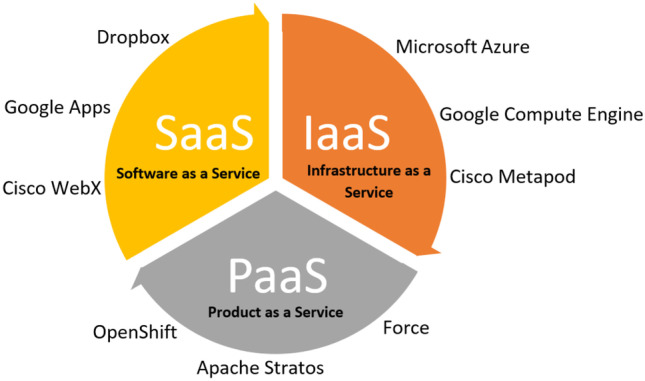
Types of Cloud Computing Services with examples
WFH using Cloud Computing can easily be imparted for IT/Service sector organization, customer service/care provider, e-commerce, banking, design labs, manufacturing etc. during this pandemic time. The productivity of an average person working from home increases by up to 42% using Cloud Computing [87]. The global market shut down and supply chain disruption have created a shortage of high-end computing devices (like computers and workstations) [88]. Consequently, a large number of working professionals were offered WFH using cloud computing platforms with their own devices and hence saving the cost for the company. Working on a Cloud Computing platform ensures data security [89] and provide high computing capability and efficiency which minimizes system lags and maintains the productivity of employees from their home.
Discussion
Application of Digital Technologies and Industry 4.0 tools is no more a futuristic matter. In every field, Digital Technologies and Industry 4.0 tools/techniques are affecting our lives, environment, flora, and fauna. The use and penetration of Digital Technologies and Industry 4.0 techniques during the COVID-19 pandemic are unprecedented and will continue so. Autonomous robots were used in hospitals and industries in Brazil, France, Italy, UK, USA; Big Data and 3D Printings were widely used in medical applications, hospitals and other areas in many countries including Australia, Denmark, India, Italy, South Korea, Taiwan, UK, and the USA. Telemedicine is getting popularity and wide acceptance in developing and developed countries including India, Bangladesh, Pakistan, Nigeria, Ethiopia, Australia, USA, Canada, and New Zealand. Artificial Intelligence, Virtual Reality, Biosensors and IoT are well received in hospitals, medical applications, industry, residential houses, and other areas in India, the USA, UK, South Korea, Israel, Spain and many more countries. Similarly, other Digital Technologies and Industry 4.0 tools such as Drone are used in surveillance, non-contact postal delivery, and crowd pictures in many countries including Australia, China, and the USA. Cloud Computing, Contact Tracing and Cybersecurity are used in Australia, Brazil, China, India, Israel, Japan, New Zealand, Saudi Arabia, South Korea, Taiwan, the USA, UK, Europe, and Africa. 3D printing technology was widely used in the manufacturing of PPE, and other devices to safeguard against COVID-19. Popular Digital Technologies and Industry 4.0 tools used during COVID-19 since 2020 are summarized in Table 4. The application and uses of these technologies and tools will certainly continue and play a pivotal role in healthcare services delivery worldwide during and post-COVID-19 period.
Table 4.
Digital Technologies and Industry 4.0 technique implemented in fighting COVID-19 across the world since 2020
| Digital Technologies |
Application during COVID-19 |
Major Area | Country | Ref |
|---|---|---|---|---|
| Autonomous Robot | Autonomous Robot has numerous applications in the field of the manufacturing industry, hospitality industry (hotels), aviation, hospital, surveillance, border security and many more. Autonomous Robot ‘Tommy’ is used to care for COVID-19 patients | Hospitals/ healthcare services | Italy | [90] |
| Telemedicine | Hospitals/ healthcare centres located in remote areas could be easily accessed from well-equipped hospitals of metro areas and hence a better consulting and treatment can be provided to patients. RP-VITA made by iRobot: allows medical specialists to communicate remotely with patients | Hospitals/ healthcare services | USA, India, Bangladesh, and other countries | [90] |
| Drone | Police Patrolling | Cities, towns, rural areas | India, USA | [90] |
| Contact tracing apps | Helps to identify persons who may have been in contact with a COVID infected individual | All possible areas | Australia, Canada, Germany, France, UK, China, Japan, India, Bangladesh, and 50 + countries | [91] |
| Advanced Robotics | Fast medicine and equipment production and reduce human interaction leads to less virus transmission | Industries | Italy, Brazil, US, France, UK | [40] |
| Big Data | To store and analyze data | Hospitals/ healthcare services | South Korea, Taiwan | [92] |
| 3D printing | It is used in the manufacturing and fabrication of sophisticated components including aerospace, defence, automobile, home appliance and medical field. 3D Printing is also used to make ventilator parts, masks, respirators, and personal protective equipment (PPE), face shields, masks, nasal swabs, 3D-printed robot help to Perform throat swab testing with zero human contact | All medical fields | Australia, UK, USA, India, Denmark, Italy | [19] |
| Artificial Intelligence | Al does the task by training machines using BIG Data in areas of banking & finance, healthcare, agriculture, gaming, space Exploration, social media, Cybersecurity. etc. AI-based chest X-ray diagnosis technology is used for Rapid detection of suspected Covid-19 | Hospitals/ healthcare services | UK, India, USA | [25–27] |
| Virtual reality | Virtual reality is used in the study of Engineering, Medical and Architectural sciences. Using holography, the concept makes easier to understand and interestingly it could be carried out online as well as offline education. Virtual reality is used for rendering infected areas, healthcare professional training, real-time education for the student | Home, hospitals/ healthcare services | USA, South Korea | [93] |
| Biosensor | Biosensor helps extract and monitor different types of data of the human body thereby easy and early detection of various diseases without carrying out an expensive body checkup. Biosensors are used for fast COVID-19 diagnosis. Life signals biosensors wireless patch can help in continuous remote monitoring of COVID-19 patient/suspect | All medical fields | South Korea, Israel, Taiwan, India | [51, 86] |
| IoT |
Tracking, screening, Monitoring data |
Homes, public areas, hospitals/ healthcare services |
India, Spain, USA, South Korea |
[94] |
| Cloud computing | Cloud computing helps to store medical data on the cloud and give assistance in curing patient infected with various disease easily. During COVID-19, work from home environment could be easily created in various locations of the city as well as the town. Office collaboration within businesses, increase in remote education and training at educational institution levels |
Banking and finances, healthcare, manufacturing sectors, etc |
India, Singapore, Australia, Hong Kong | [95] |
| Cybersecurity | Prevention from hacking and cyber-attack in name of COVID-19 | Defence, internal agencies, big organization | India, Israel | [89] |
Conclusions
The impact of COVID-19 on healthcare services delivery is innumerable. Digital Technologies and Industry 4.0 tools/ techniques have shown immense capabilities that can be used to change the scenario of the present world during and post COVID-19 pandemic. COVID-19 played a vital role in the improvement and development of medical and healthcare facilities, and service delivery.
Digital Health/Telemedicine plays a crucial role in healthcare service delivery to vulnerable and immunocompromised people globally thereby protecting them from COVID-19 infection and minimising the COVID-19 infection to frontline healthcare professionals by reducing interhuman contagion. This allows diverting resources and facilities for COVID patients’ treatment and care.
3D printing as rapid prototype manufacturing shows its immense capabilities in manufacturing of PPE, face shield, mask, nasal swabs, etc. 3D printing allows fast and customised production of COVID-19 protective equipment.
Autonomous Robot allows providing non-contact services to COVID-19 patients. The application of an autonomous robot minimises the direct contact with COVID-19 patients and, also allows undertaking disinfection work; thereby reducing the spread of COVID infection and viruses.
Biosensors offer huge benefits for COVID-19 detection. Once the infection is detected, the cases can be isolated thereby slowing down the virus-spread. Two biosensors (electrochemical and optical) can be used for simple, rapid, and low-cost detection of COVID-19 from saliva.
The data size in the health care industry is massive and growing rapidly that needs to be securely collected, processed, stored, and shared among stakeholders within the national boundary and beyond. Cloud computing serves as a perfect platform to effectively use and share vast healthcare data among stakeholders (healthcare professionals, hospitals, pharmaceutical benefits schemes, medical research centres and national vaccination data centres). Cloud computing with integrated use of IoTs, Artificial Intelligence, and Machine Learning will provide citizens with full control over their health data, security, and misuse prevention.
Digital Technologies and Industry 4.0 tools/techniques implemented for fighting COVID-19 offer an opportunity for developing and developed countries to create a framework for integrated healthcare service delivery during and post-COVID period.
Authors' contributions
Mukesh Chandra: Paper conceptualization, Preparation of first draft of manuscript, data collection, and analysis; Kunal Kumar: Data collection, and analysis; Prabhat Thakur; Data collection, and analysis; Somnath Chattopadhyaya: Updating, formatting and reviewing; Firoz Alam: Updating, formatting and reviewing: Satish Kumar: Paper conceptualization.
Funding
Not applicable.
Declarations
Ethics approval
Not applicable.
Consent to participate
Not applicable.
Consent for publication
Not applicable.
Conflicts of interest
The authors have no conflicts of interest to declare that are relevant to the content of this article.
Footnotes
This article is part of the COVID-19 Health Technology: Design, Regulation, Management, Assessment
Publisher's Note
Springer Nature remains neutral with regard to jurisdictional claims in published maps and institutional affiliations.
Contributor Information
Mukesh Chandra, Email: mchandra018@gmail.com.
Kunal Kumar, Email: kunal.kk.jsr@gmail.com.
Prabhat Thakur, Email: prabhat28thakur@gmail.com.
Somnath Chattopadhyaya, Email: somnathchattopadhyaya@iitism.ac.in.
Firoz Alam, Email: firoz.alam@rmit.edu.au.
Satish Kumar, Email: satistme@mnnit.ac.in.
References
- 1.World Health Organization. “WHO Coronavirus (COVID-19) Dashboard.” 2021.
- 2.Davis J, Edgar T, Porter J, Bernaden J, Sarli M. Smart manufacturing, manufacturing intelligence and demand-dynamic performance. Comput Chem Eng. 2012;47:145–156. doi: 10.1016/j.compchemeng.2012.06.037. [DOI] [Google Scholar]
- 3.Alam F, Kootsookos A. Engineering Education: Accreditation & Graduate Global Mobility. CRC Press. 2020.
- 4.Wang Z, Tang K. Combating COVID-19: health equity matters. Nat Med. 2020;26(4):458. doi: 10.1038/s41591-020-0823-6. [DOI] [PubMed] [Google Scholar]
- 5.Tian S, Yang W, Le Grange JM, Wang P, Huang W, Ye Z. Smart healthcare: making medical care more intelligent. J Glob Health. 2019;3(3):62–65. doi: 10.1016/j.glohj.2019.07.001. [DOI] [Google Scholar]
- 6.Javaid M, Haleem A, Vaishya R, Bahl S, Suman R, Vaish A. “Industry 4.0 technologies and their applications in fighting COVID-19 pandemic”. Diabetes Metab Syndr Clin Res Rev. no. January, 2020. [DOI] [PMC free article] [PubMed]
- 7.Kumar MS, Raut DRD, Narwane DVS, Narkhede DBE. Applications of industry 4.0 to overcome the COVID-19 operational challenges. Diabetes Metab Syndr Clin Res Rev. 2020;14(5):1283–1289. doi: 10.1016/j.dsx.2020.07.010. [DOI] [PMC free article] [PubMed] [Google Scholar]
- 8.Khan H, Kushwah KK, Singh S, Urkude H, Maurya MR, Sadasivuni KK. “Smart technologies driven approaches to tackle COVID-19 pandemic: a review”. 3 Biotech. 2021;11(2):1–22. [DOI] [PMC free article] [PubMed]
- 9.Acioli C, Scavarda A, Reis A. “Applying Industry 4.0 technologies in the COVID–19 sustainable chains”. Int J Prod Performance Manag vol. ahead-of-p, no. ahead-of-print. 01-Jan-2021.
- 10.Mbunge E, Akinnuwesi B, Fashoto SG, Metfula AS, Mashwama P. A critical review of emerging technologies for tackling COVID-19 pandemic. Hum Behav Emerg Technol. 2020;2(November):1–15. doi: 10.1002/hbe2.237. [DOI] [PMC free article] [PubMed] [Google Scholar]
- 11.Golinelli D, Boetto E, Carullo G, Nuzzolese AG, Landini MP, Fantini MP. “How the COVID-19 pandemic is favoring the adoption of digital technologies in healthcare: A literature review.” medRxiv. 2020;0–2. [DOI] [PMC free article] [PubMed]
- 12.Budd J, et al. Digital technologies in the public-health response to COVID-19. Nat Med. 2020;26(8):1183–1192. doi: 10.1038/s41591-020-1011-4. [DOI] [PubMed] [Google Scholar]
- 13.OECD. “The state of school education: One year into the COVID pandemic.” OECD Paris, 2021.
- 14.Senbekov M, et al. “The recent progress and applications of digital technologies in healthcare: A review”. Int. J. Telemed. Appl. 2020;2020. [DOI] [PMC free article] [PubMed]
- 15.Horn TJ, Harrysson OLA. Overview of current additive manufacturing technologies and selected applications. Sci Prog. 2012;95(3):255–282. doi: 10.3184/003685012X13420984463047. [DOI] [PMC free article] [PubMed] [Google Scholar]
- 16.Ashima R, Haleem A, Bahl S, Javaid M, Mahla SK, Singh S. “Automation and manufacturing of smart materials in additive manufacturing technologies using Internet of Things towards the adoption of industry 4.0”. Mater. Today Proc. 2021.
- 17.Larrañeta E, Dominguez-Robles J, Lamprou DA. “Additive Manufacturing Can Assist in the Fight Against COVID-19 and Other Pandemics and Impact on the Global Supply Chain”, 3D Print. Addit Manuf. 2020;7(3):100–103. doi: 10.1089/3dp.2020.0106. [DOI] [PMC free article] [PubMed] [Google Scholar]
- 18.Salmi M, Akmal JS, Pei E, Wolff J, Jaribion A, Khajavi SH. 3D printing in COVID-19: Productivity estimation of the most promising open source solutions in emergency situations. Appl Sci. 2020;10(11):1–15. doi: 10.3390/app10114004. [DOI] [Google Scholar]
- 19.Tino R, et al. “COVID-19 and the role of 3D printing in medicine”, 3D Print. Med. 2020;6(1):1–8. doi: 10.1186/s41205-020-00064-7. [DOI] [PMC free article] [PubMed] [Google Scholar]
- 20.Siemens Centre of Excellence of NIT T.“https://www.nitt.edu/home/students/events/covid19/covid-press-release6.pdf”. 2020.
- 21.Erickson MM, Richardson ES, Hernandez NM, Bobbert II DW, Gall K, Fearis P. “Helmet Modification to PPE With 3D Printing During the COVID-19 Pandemic at Duke University Medical Center: A Novel Technique”. J Arthroplasty. 2020;4–8. [DOI] [PMC free article] [PubMed]
- 22.Kuka. “COVID-19 test robot as a tireless colleague in the fight against the virus”. 2020. [Online]. Available: https://www.kuka.com/en-us/company/press/news/2020/06/robot-helps-with-coronavirus-tests. [Accessed: 21-Dec-2020].
- 23.Quin M. “Stepping up to shield our healthcare workers from infection.” Advanced Manufacturing Precinct (AMP), RMIT University, Melbourne, Australia. [Online]. Available: https://www.rmit.edu.au/news/all-news/2020/april/face-shields. [Accessed: 13-Jun-2021].
- 24.Chodak G, Chawla Y. “Artificial Intelligence Market Size, Share & Trends Analysis Report By Solution, By Technology (Deep Learning, Machine Learning, Natural Language Processing, Machine Vision), By End Use, By Region, And Segment Forecasts, 2021 - 2028”. Grand View Research. 2021. [Online]. Available: https://www.grandviewresearch.com/industry-analysis/artificial-intelligence-ai-market.
- 25.Jiang F, et al. Artificial intelligence in healthcare: Past, present and future. Stroke Vasc Neurol. 2017;2(4):230–243. doi: 10.1136/svn-2017-000101. [DOI] [PMC free article] [PubMed] [Google Scholar]
- 26.Vaishya R, Javaid M, Khan IH, Haleem A. Artificial Intelligence (AI) applications for COVID-19 pandemic. Diabetes Metab Syndr Clin Res Rev. 2020;14(4):337–339. doi: 10.1016/j.dsx.2020.04.012. [DOI] [PMC free article] [PubMed] [Google Scholar]
- 27.Ho CWL, Soon D, Caals K, Kapur J. Governance of automated image analysis and artificial intelligence analytics in healthcare. Clin Radiol. 2019;74(5):329–337. doi: 10.1016/j.crad.2019.02.005. [DOI] [PubMed] [Google Scholar]
- 28.Rajaraman S, Antani S. Weakly labeled data augmentation for deep learning: A study on COVID-19 detection in chest X-rays. Diagnostics. 2020;10(6):1–17. doi: 10.3390/diagnostics10060358. [DOI] [PMC free article] [PubMed] [Google Scholar]
- 29.Yan L, et al. An interpretable mortality prediction model for COVID-19 patients. Nat Mach Intell. 2020;2(5):283–288. doi: 10.1038/s42256-020-0180-7. [DOI] [Google Scholar]
- 30.Marabelli M, Vaast E, Li JL. Preventing the digital scars of COVID-19. Eur J Inf Syst. 2021;00(00):1–17. [Google Scholar]
- 31.Mohanty S, Rashid MH, Mridul M, Mohanty C, Swayamsiddha S. “Application of Artificial Intelligence in COVID-19 drug repurposing”. Diabetes Metab Syndr Clin Res Rev. 2020;14(5):1027–1031. [DOI] [PMC free article] [PubMed]
- 32.Alabool H, et al. “Artificial intelligence techniques for Containment COVID-19 Pandemic: A Systematic Review”. Res. Sq. 2020.
- 33.Fang H, Zhang Z, Wang CJ, Daneshmand M, Wang C, Wang H. “A survey of big data research”. IEEE Network Inc. 2015;29(5):6–9. [DOI] [PMC free article] [PubMed]
- 34.Oussous A, Benjelloun FZ, Lahcen AA, Belfkih S. “Big Data technologies: A survey”. J King Saud University - Comp Information Sci, vol. 30, no. 4. King Saud bin Abdulaziz University pp. 431–448, Oct-2018.
- 35.Razzak MI, Naz S, Zaib A. “Deep learning for medical image processing: Overview, challenges and the future”. Classif. BioApps. 2018;323–350.
- 36.Wang X, Wang H, Niu S, Zhang J. Detection and localization of image forgeries using improved mask regional convolutional neural network. Math Biosci Eng. 2019;16(5):4581–4593. doi: 10.3934/mbe.2019229. [DOI] [PubMed] [Google Scholar]
- 37.Ouyang X, et al. Dual-Sampling Attention Network for Diagnosis of COVID-19 from Community Acquired Pneumonia. IEEE Trans Med Imaging. 2020;39(8):1–1. doi: 10.1109/TMI.2020.2995508. [DOI] [PubMed] [Google Scholar]
- 38.Wang S. et al. “A deep learning algorithm using CT images to screen for Corona Virus Disease (COVID-19)”. Eur. Radiol. 2021;1–9. [DOI] [PMC free article] [PubMed]
- 39.Ahmed ST, Khadhim BJ, Kadhim QK. “A Survey on Deep Transfer Learning to Edge Computing for Mitigating the COVID-19 Pandemic: DTL-EC”. J Syst Archit. 2020;108:101830.
- 40.Khan ZH, Siddique A, Lee CW. “Robotics utilization for healthcare digitization in global COVID-19 management”. Int J Environ Res Public Health. 2020;17(11). [DOI] [PMC free article] [PubMed]
- 41.Chen B, Marvin S, While A. “Containing COVID-19 in China: AI and the robotic restructuring of future cities”. Dialogues Hum Geogr. 2020.
- 42.Ozkil AG, Fan Z, Dawids S, Aanes H, Kristensen JK, Christensen KH. “Service robots for hospitals: A case study of transportation tasks in a hospital”, in. IEEE international conference on automation and logistics. 2009;2009:289–294. [Google Scholar]
- 43.Yang GZ, et al. Combating COVID-19-The role of robotics in managing public health and infectious diseases. Sci Robot. 2020;5(40):1–2. doi: 10.1126/scirobotics.abb5589. [DOI] [PubMed] [Google Scholar]
- 44.Torabiparizi A, Tavakoli M. “Robotics, Smart Wearable Technologies, and Autonomous Intelligent Systems for Healthcare During the COVID-19 Pan”. 2020.
- 45.Sawant SN. “Development of Biosensors from Biopolymer Composites”. Biopolym Compos Electron. 2017;353–383.
- 46.Morales-Narváez E, Dincer C. “The impact of biosensing in a pandemic outbreak: COVID-19”. Biosens. Bioelectron. 2020. [DOI] [PMC free article] [PubMed]
- 47.Abid SA, et al. “Biosensors as a future diagnostic approach for COVID-19,” Life Sci. 2021;119117. [DOI] [PMC free article] [PubMed]
- 48.Mehrotra P. Biosensors and their applications - A review. J Oral Biol Craniofacial Res. 2016;6(2):153–159. doi: 10.1016/j.jobcr.2015.12.002. [DOI] [PMC free article] [PubMed] [Google Scholar]
- 49.Yoo EH, Lee SY. Glucose biosensors: An overview of use in clinical practice. Sensors. 2010;10(5):4558–4576. doi: 10.3390/s100504558. [DOI] [PMC free article] [PubMed] [Google Scholar]
- 50.Lee M, et al. A novel biosensor based on hafnium oxide: Application for early stage detection of human interleukin-10. Sensors Actuators B Chem. 2012;175:201–207. doi: 10.1016/j.snb.2012.04.090. [DOI] [Google Scholar]
- 51.Singh P, Pandey SK, Singh J, Srivastava S, Sachan S, Singh SK. Biomedical Perspective of Electrochemical Nanobiosensor. Nano-Micro Lett. 2016;8(3):193–203. doi: 10.1007/s40820-015-0077-x. [DOI] [PMC free article] [PubMed] [Google Scholar]
- 52.Lee G, Park D, Kim H, Kim S. “Rapid Detection of COVID-19 Causative Virus (SARS-CoV-2) in Human Nasopharyngeal Swab Specimens Using Field-Effect Transistor-Based Biosensor”. ACSNANO. 2020. [DOI] [PubMed]
- 53.WHO. “Telemedicine: opportunities and developments in member states”. 2010.
- 54.Bitar H, Alismail S. “The Role of EHealth, Telehealth, and Telemedicine for Chronic Disease Patients during COVID-19 Pandemic: A Rapid Systematic Review.” Digital health. 2021. [DOI] [PMC free article] [PubMed]
- 55.Fatehi F, Wootton R. Telemedicine, telehealth or e-health? A bibliometric analysis of the trends in the use of these terms. J Telemed Telecare. 2012;18(8):460–464. doi: 10.1258/jtt.2012.gth108. [DOI] [PubMed] [Google Scholar]
- 56.Kinsinger LS, et al. Implementation of lung cancer screening in the Veterans Health Administration. JAMA Intern Med. 2017;177(3):399–406. doi: 10.1001/jamainternmed.2016.9022. [DOI] [PubMed] [Google Scholar]
- 57.Murillo-Cabezas F, Vigil-Mart E, Raimondi N, Pérez-Fernández J. “Covid-19 pandemic and digital transformation in critical care units”. Med intensiva. 2020;44(7):457. [DOI] [PMC free article] [PubMed]
- 58.Kadir MA. “Role of telemedicine in healthcare during COVID-19 pandemic in developing countries”. Telehealth Med Today. 2020.
- 59.Jin MX, Kim SY, Miller LJ, Behari G, Correa R. “Telemedicine: Current Impact on the Future”. Cureus. 2020;12(8). [DOI] [PMC free article] [PubMed]
- 60.Bashshur R, Doarn CR, Frenk JM, Kvedar JC, Woolliscroft JO. Telemedicine and the COVID-19 Pandemic, Lessons for the Future. Telemed e-Health. 2020;26(5):571–573. doi: 10.1089/tmj.2020.29040.rb. [DOI] [PubMed] [Google Scholar]
- 61.Iyengar K, Upadhyaya GK, Vaishya R, Jain V. Diabetes & Metabolic Syndrome : Clinical Research & Reviews COVID-19 and applications of smartphone technology in the current pandemic. Diabetes Metab Syndr Clin Res Rev. 2020;14(5):733–737. doi: 10.1016/j.dsx.2020.05.033. [DOI] [PMC free article] [PubMed] [Google Scholar]
- 62.Iyengar K, Mabrouk A, Jain VK, Venkatesan A, Vaishya R. “Learning opportunities from COVID-19 and future effects on health care system”. Diabetes Metab Syndr Clin Res Rev. 2020. [DOI] [PMC free article] [PubMed]
- 63.Ajadi S, Peter D. “Health Systems , Digital Health and COVID-19”.GSMA. 2021.
- 64.Shiferaw KB, et al. “Healthcare providers acceptance of telemedicine and preference of modalities during COVID-19 pandemics in a low-resource setting: An extended UTAUT model”. PLoS One. 2021;16(4):e0250220. [DOI] [PMC free article] [PubMed]
- 65.Singh RP, Javaid M, Haleem A, Suman R. Internet of things (IoT) applications to fight against COVID-19 pandemic. Diabetes Metab Syndr Clin Res Rev. 2020;14(4):521–524. doi: 10.1016/j.dsx.2020.04.041. [DOI] [PMC free article] [PubMed] [Google Scholar]
- 66.Swayamsiddha S, Mohanty C. “Application of cognitive Internet of Medical Things for COVID-19 pandemic”. Diabetes Metab Syndr Clin Res Rev. 2020. [DOI] [PMC free article] [PubMed]
- 67.Amin R, Islam SH, Biswas GP, Khan MK, Kumar N. A robust and anonymous patient monitoring system using wireless medical sensor networks. Futur Gener Comput Syst. 2018;80:483–495. doi: 10.1016/j.future.2016.05.032. [DOI] [Google Scholar]
- 68.Romeo L, Petitti A, Marani R, Milella A. Internet of robotic things in smart domains: Applications and challenges. Sensors (Switzerland) 2020;20(12):1–23. doi: 10.3390/s20123355. [DOI] [PMC free article] [PubMed] [Google Scholar]
- 69.Bai L, et al. Chinese experts’ consensus on the Internet of Things-aided diagnosis and treatment of coronavirus disease 2019 (COVID-19) Clin eHealth. 2020;3:7–15. doi: 10.1016/j.ceh.2020.03.001. [DOI] [Google Scholar]
- 70.Nasajpour M, Pouriyeh S, Parizi RM, Dorodchi M, Valero M, Arabnia HR. “Internet of Things for current COVID-19 and future pandemics: An exploratory study”. J Healthc informatics Res. 2020;1–40. [DOI] [PMC free article] [PubMed]
- 71.Government of Singapore, “TraceTogether, safer together”, 2020 [Online]. Available: https://www.tracetogether.gov.sg/. [Accessed 25 Nov 2021].
- 72.Halabi T, Bellaiche M. “Providers”. J Inf Secur Appl. 2017;0:1–11.
- 73.Nayyar A, Nguyen BL, Nguyen NG. “The internet of drone things (IoDT): future envision of smart drones,” in First international conference on sustainable technologies for computational intelligence. 2020;563–580.
- 74.Mohammed M, Hazairin NA, Al-Zubaidi S, AK S, Mustapha S, Yusuf E. “Toward a novel design for coronavirus detection and diagnosis system using iot based drone technology”. Int J Psychosoc Rehabil. 2020;24(7):2287–2295.
- 75.Choudhary M. “How IoT can help fight COVID-19 battle,” 2021. [Online]. Available: https://bit.ly/2MNQvD0. [Accessed: 24-Nov-2021].
- 76.D’mello A. “First IoT buttons shipped for rapid response to cleaning alerts,” 2020. [Online]. Available: https://bit.ly/2MSy7Zy. [Accessed: 20-Nov-2021].
- 77.“IoT alert button finds new uses during coronavirus pandemic,” 2020. [Online]. Available: https://www.med-technews.com/news/iot-alert-button-finds-new-uses-during-coronavirus-pandemic/. [Accessed: 22-Nov-2021].
- 78.Ni AY. Methods Comparing the Effectiveness of Classroom and Online Learning: Teaching Research Methods. J Public Aff Educ. 2016;19(2):199–215. doi: 10.1080/15236803.2013.12001730. [DOI] [Google Scholar]
- 79.Petrakou A. Interacting through avatars: Virtual worlds as a context for online education. Comput Educ. 2010;54(4):1020–1027. doi: 10.1016/j.compedu.2009.10.007. [DOI] [Google Scholar]
- 80.Labovitz J, Hubbard C. The Use of Virtual Reality in Podiatric Medical Education. Clin Podiatr Med Surg. 2020;37(2):409–420. doi: 10.1016/j.cpm.2019.12.008. [DOI] [PubMed] [Google Scholar]
- 81.Haluck RS, Krummel TM. Computers and virtual reality for surgical education in the 21st century. Arch Surg. 2000;135(7):786–792. doi: 10.1001/archsurg.135.7.786. [DOI] [PubMed] [Google Scholar]
- 82.Liebermann A, Erdelt K. “Virtual education: Dental morphologies in a virtual teaching environment”. J Dent Educ. 2020;1–8. [DOI] [PubMed]
- 83.MoE I. “Broad Areas of Virtual Labs,” 2021. [Online]. Available: https://www.vlab.co.in/. [Accessed: 19-Jul-2021].
- 84.Porpiglia F, Checcucci E, Autorino R, Amparore D, Cooperberg MR, Ficarra V, Novara G. “Traditional and Virtual Congress Meetings During the COVID-19 Pandemic and the Post-COVID-19 Era: Is it Time to Change the Paradigm?”. Eur Urol. 2020;EURURO-881. [DOI] [PMC free article] [PubMed]
- 85.Singh RP, Javaid M, Kataria R, Tyagi M, Haleem A, Suman R. Significant applications of virtual reality for COVID-19 pandemic. Diabetes Metab Syndr Clin Res Rev. 2020;14(4):661–664. doi: 10.1016/j.dsx.2020.05.011. [DOI] [PMC free article] [PubMed] [Google Scholar]
- 86.Mell P, Grance T, Grance T. “The NIST Definition of Cloud Computing Recommendations of the National Institute of Standards and Technology”.
- 87.Vyas L, Butakhieo N. The impact of working from home during COVID-19 on work and life domains: an exploratory study on Hong Kong. Policy Des Pract. 2021;4(1):59–76. [Google Scholar]
- 88.Guan D, et al. “Global supply-chain effects of COVID-19 control measures”. Nat. Hum. Behav. 2020. [DOI] [PubMed]
- 89.Halabi T, Bellaiche M. “Towards quantification and evaluation of security of Cloud Service Providers". J Inf Secur Appl. 2017.
- 90.Romero ME. “Tommy the robot nurse helps Italian doctors care for COVID-19 patients”. The World. 2020.
- 91.“COVID-19 apps”. wikipedia.org. 2020.
- 92.Dzuroska F. “Coronavirus: A Big Data lesson from South Korea.” https://medium.com/. 2020.
- 93.Heather Graf WS. “GWU Hospital doctor’s new research of COVID-affected lungs using virtual reality”. wjla.com. 2020.
- 94.Mishra S. “The Growing Role Of IoT In COVID-19 Response”. 2020.
- 95.Singh A. “As Covid-19 impacts Asian markets, cloud outshines traditional products”. Channel Asia. 2020.



